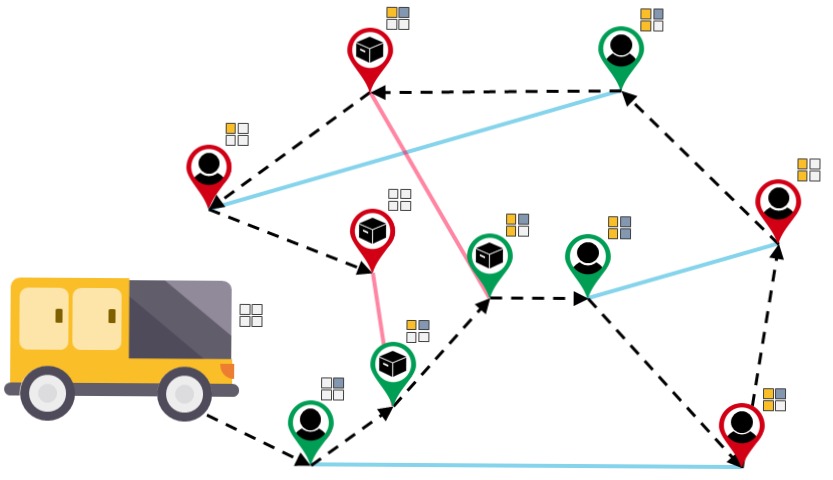1. Introduction
The rapid rise of autonomous vehicles is transforming the transportation and logistics sectors, with fleet management emerging as a critical component in ensuring their efficiency, safety, and profitability. Autonomous Vehicle Fleet Management refers to the oversight and coordination of self-driving vehicles within a network, using advanced technologies to optimize operations with minimal human intervention.
In a highly competitive market where speed, accuracy, and cost-efficiency are paramount, autonomous fleets offer businesses a strategic advantage. By leveraging artificial intelligence (AI), Internet of Things (IoT) connectivity, telematics, and cloud-based analytics, fleet managers can monitor vehicle performance in real time, anticipate maintenance needs, and dynamically adjust routes based on traffic and weather conditions.
This shift from traditional to autonomous fleet management is more than just a technological upgrade—it represents a fundamental change in how transportation systems operate. The following sections explore the tools, trends, and technologies driving this transformation, real-world applications, key challenges, and the future outlook for autonomous fleet management in diverse industries.
2. Understanding Autonomous Vehicle Fleet Management
Autonomous Vehicle Fleet Management refers to the coordinated oversight, operation, and optimization of multiple self-driving vehicles within a logistics, transportation, or service network. Unlike traditional fleet management, which relies heavily on human drivers and manual monitoring, autonomous fleet management leverages advanced technologies to enable vehicles to operate with minimal or no human intervention.
The primary goal is to ensure that every vehicle in the fleet operates safely, efficiently, and in alignment with operational objectives such as timely deliveries, cost control, and asset longevity. This involves real-time tracking, route optimization, predictive maintenance, and seamless integration with broader supply chain or mobility systems.
Autonomous fleets rely on a combination of Artificial Intelligence (AI), telematics, IoT sensors, and data analytics to make informed decisions. For example, AI algorithms can reroute a delivery van in real time to avoid traffic congestion, while predictive analytics can schedule maintenance before a mechanical issue causes downtime.
A key difference from conventional fleet management is the reduced need for human decision-making in day-to-day operations. Instead, managers focus on strategic oversight, regulatory compliance, and system optimization.
As autonomous technology matures, fleet management will increasingly center on managing data flows, ensuring cybersecurity, and coordinating mixed fleets that include both autonomous and human-driven vehicles. This evolution marks a significant shift toward smarter, more efficient, and highly connected transportation networks.

3. Essential Tools for Managing Autonomous Fleets
Effectively managing an autonomous vehicle fleet requires a robust ecosystem of digital tools, hardware systems, and integrated platforms. These tools work together to ensure vehicles operate safely, efficiently, and in compliance with regulatory standards.
Fleet Management Software (FMS)
FMS acts as the central hub for monitoring and controlling fleet operations. It provides real-time tracking, performance analytics, route assignments, and maintenance schedules. For autonomous fleets, FMS must also process data from onboard sensors, navigation systems, and AI modules to make rapid, informed decisions.
Telematics Systems
Telematics combines GPS tracking, onboard diagnostics, and wireless communication to deliver location data, vehicle health updates, and operational insights. In autonomous fleets, telematics ensures seamless route optimization, fuel efficiency monitoring, and real-time reporting of potential issues.
AI-Powered Decision-Making Platforms
AI algorithms process vast amounts of real-time data to optimize routes, predict maintenance needs, and adapt to unexpected events like traffic jams or weather changes. This reduces downtime and improves service reliability.
Data Integration Platforms
A modern autonomous fleet requires integration between vehicles, warehouses, dispatch centers, and customer systems. These platforms ensure smooth communication between different parts of the supply chain, enabling coordinated deliveries and minimizing delays.
Predictive Maintenance Tools
Using IoT sensors, predictive maintenance software identifies wear and tear before breakdowns occur. This not only reduces repair costs but also keeps fleets operational for longer periods without interruptions.
Cybersecurity Systems
With connected fleets, securing communication channels and vehicle control systems is critical. Cybersecurity tools protect against hacking attempts, data breaches, and unauthorized system access.
By combining these essential tools, fleet managers can achieve full visibility, control, and efficiency over autonomous operations, ensuring safety, compliance, and profitability in a highly competitive transportation landscape.
4. Emerging Trends in Autonomous Fleet Management
The field of autonomous fleet management is rapidly evolving, driven by technological innovation, regulatory changes, and shifting market demands. Several emerging trends are shaping the way fleets are monitored, maintained, and optimized.
Growth of Mobility-as-a-Service (MaaS)
Fleet management is expanding beyond traditional logistics to support MaaS platforms, where autonomous vehicles are shared across multiple users and applications, such as ride-hailing, last-mile delivery, and corporate shuttles. This trend increases fleet utilization rates and revenue potential.
IoT Integration for Real-Time Data
Internet of Things (IoT) devices enable continuous monitoring of vehicle health, environmental conditions, and operational status. This allows fleet managers to respond instantly to issues, optimize routes based on traffic and weather, and ensure compliance with safety regulations.
Edge Computing for Low-Latency Decisions
With edge computing, autonomous vehicles can process critical data locally rather than relying solely on cloud systems. This results in faster decision-making for collision avoidance, dynamic rerouting, and emergency responses.
Heightened Cybersecurity Measures
As fleets become more connected, the risk of cyberattacks grows. Fleet management systems are increasingly adopting blockchain verification, multi-factor authentication, and intrusion detection systems to safeguard data and control systems.
Digital Twin Technology
Digital twins—virtual replicas of physical vehicles—allow fleet managers to simulate real-world scenarios, test route changes, and predict wear-and-tear before implementing decisions in the actual fleet.
Sustainability and Green Fleet Initiatives
With environmental regulations tightening, autonomous fleets are moving toward electric and hybrid models, supported by energy-efficient routing and regenerative braking systems to reduce carbon emissions.
These trends are not only improving efficiency and safety but also transforming autonomous fleet management into a more adaptive, data-driven, and sustainable discipline, positioning it as a cornerstone of future transportation ecosystems.
5. Core Technologies Driving the Future
The success of autonomous vehicle fleet management relies on a sophisticated combination of hardware and software technologies that enable vehicles to operate safely, efficiently, and intelligently. These core technologies are shaping the future of the industry.
Artificial Intelligence (AI) and Machine Learning
AI powers decision-making processes, from route optimization to obstacle detection. Machine learning models continuously improve performance by learning from historical data, enabling predictive capabilities such as maintenance scheduling and traffic pattern forecasting.
Lidar, Radar, and Advanced Camera Systems
These sensors act as the “eyes” of autonomous vehicles, enabling precise navigation and environment mapping. Lidar provides 3D mapping, radar excels in detecting objects in poor visibility, and high-resolution cameras handle object recognition and lane detection. Together, they ensure situational awareness in all conditions.
Vehicle-to-Everything (V2X) Communication
V2X technology enables autonomous vehicles to communicate with each other, infrastructure (like traffic lights), and control centers. This enhances coordination, prevents collisions, and optimizes traffic flow across an entire fleet.
Cloud-Based Fleet Analytics
Cloud platforms store and process vast amounts of operational data, enabling real-time monitoring, performance analysis, and seamless integration with warehouse or dispatch systems. This centralization also supports scalability as fleets expand.
Edge Computing for Real-Time Processing
By processing data locally within the vehicle, edge computing reduces latency, enabling instant responses to critical situations without relying solely on cloud connectivity.
Predictive Maintenance Systems
Using IoT sensors and analytics, predictive maintenance identifies potential mechanical issues before they cause downtime, improving fleet availability and reducing repair costs.
As these technologies continue to advance, autonomous fleet management will become smarter, safer, and more efficient—paving the way for fully automated, interconnected transportation ecosystems.
6. Real-World Applications and Case Studies
Autonomous vehicle fleet management is no longer just a concept—it is actively transforming operations across industries. Several real-world applications highlight its potential and versatility.
Logistics and Last-Mile Delivery
Companies like FedEx and UPS are integrating autonomous delivery vans and robots into their fleets to handle last-mile logistics. These vehicles use AI-powered route optimization and obstacle detection to ensure timely and efficient deliveries, especially in congested urban areas.
Retail and E-Commerce
Amazon has been at the forefront with autonomous delivery systems like the Scout robot and experimental self-driving vans. Their fleet management systems ensure coordinated operations between warehouses, fulfillment centers, and customers, reducing delivery times and operational costs.
Ride-Hailing and Mobility Services
Waymo operates a fleet of autonomous taxis in selected cities, managed through a central platform that handles ride assignments, maintenance scheduling, and customer interactions. This demonstrates the potential for shared autonomous mobility at scale.
Public Transportation
Cities like Singapore and Helsinki are piloting autonomous buses. Fleet management systems monitor routes, passenger load, and vehicle health, ensuring reliability and safety in public transit networks.
Industrial and Mining Operations
Companies like Rio Tinto use autonomous haul trucks in mining sites, managed remotely to maximize safety in hazardous environments while reducing operational costs.
These case studies reveal that autonomous fleet management is not industry-specific—it benefits logistics, retail, public transport, and even heavy industries. By leveraging real-time monitoring, predictive analytics, and advanced navigation systems, organizations are achieving higher efficiency, improved safety, and reduced operational costs, proving the transformative power of autonomous vehicle fleets in diverse sectors.
7. Challenges and Considerations
While autonomous vehicle fleet management offers transformative potential, its adoption comes with a set of challenges that organizations must address for successful implementation.
High Initial Investment
Deploying autonomous vehicles requires significant capital for vehicle procurement, sensor systems, fleet management software, and supporting infrastructure. Smaller businesses may struggle with the upfront costs, despite the long-term savings.
Regulatory and Compliance Barriers
Autonomous fleets must comply with evolving regulations, which vary across countries and regions. Meeting safety, insurance, and data privacy requirements can slow down deployment and add legal complexity.
Cybersecurity Risks
With vehicles connected to cloud and IoT systems, they become potential targets for cyberattacks. Unauthorized access could disrupt operations or compromise safety. Implementing robust cybersecurity measures is critical to prevent breaches.
Integration with Existing Systems
Many companies still operate legacy fleet management or logistics systems. Integrating autonomous fleet technologies with these systems can require custom solutions, extensive testing, and training.
Workforce Transition and Training
Shifting from human-driven fleets to autonomous ones requires retraining staff for new roles in oversight, maintenance, and data analysis. Resistance to change and skill gaps can hinder adoption.
Environmental and Operational Limitations
Autonomous systems may face challenges in extreme weather, poorly mapped areas, or unpredictable environments. Certain tasks still require human judgment, especially in complex or unstructured settings.
Addressing these challenges requires strategic planning, investment in cybersecurity, regulatory engagement, and workforce development. Organizations that prepare for these considerations early will be better positioned to leverage autonomous fleet management effectively and sustainably.
8. Conclusion
Autonomous vehicle fleet management is redefining the way businesses operate in logistics, transportation, and mobility services. By integrating advanced technologies such as AI, IoT, V2X communication, and predictive analytics, organizations can achieve greater efficiency, safety, and cost savings while reducing environmental impact.
However, the transition to autonomous fleets is not without its hurdles—high investment costs, regulatory complexities, and cybersecurity threats require careful planning and proactive strategies. Companies must also invest in workforce training and system integration to maximize the benefits of this transformation.
As the technology matures and adoption becomes more widespread, autonomous fleet management will evolve into a core component of smart, connected, and sustainable transportation ecosystems. Businesses that embrace these innovations early will be well-positioned to lead in an increasingly competitive and technology-driven marketplace.



